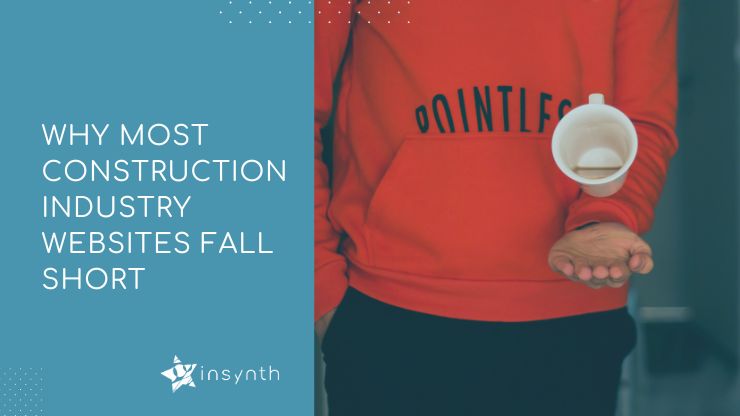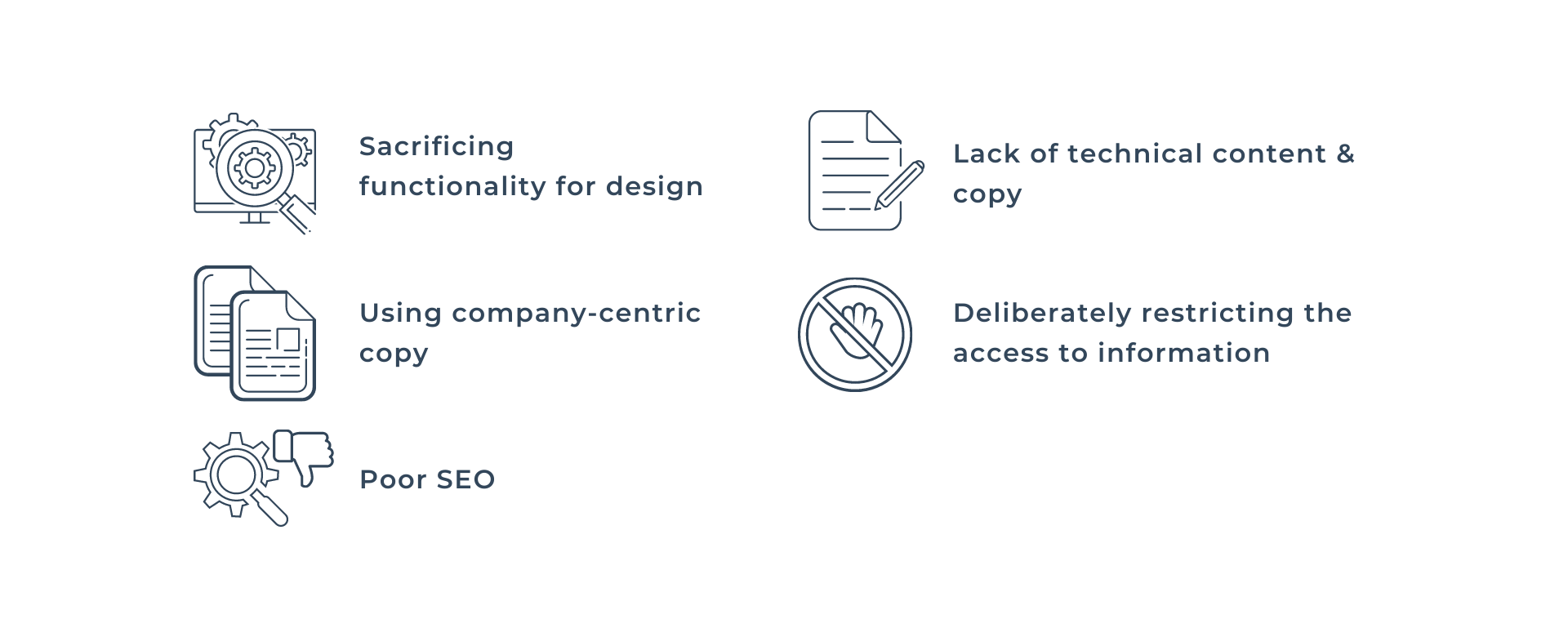
A good website is a critical asset for every business, but the unique dynamics of the construction industry make website design more complex than in other B2B sectors.
Selling products and services into building projects requires navigating and supporting the complex decision-making process of multiple stakeholders, providing up-to-date and accurate product information, catering to diverse target audiences, ensuring compliance with industry standards and guidelines, and implementing effective SEO strategies.
Unfortunately, most websites fail to meet the needs of specifiers and contractors.
This article will explore the most common problems of construction industry websites. Keep reading to learn how to create a website that meets the needs of your audience of construction professionals.
The 5 Most common problems

1. Sacrificing functionality for design
Redesign briefs often prioritise design over performance.
The result is a nice-looking website that doesn’t rank on Google, so it rarely gets visited. When it does it frustrates visitors, killing your sales opportunity stone dead.
Let's consider a situation where our website is loaded with captivating animations, striking colors, and fancy fonts. At first glance, it's truly impressive. But, as people dig deeper, they might encounter a notable issue. Navigating through the site is like trying to solve a complex maze. People struggle to find essential information about products or the decision-making process.
In our line of work, functionality is crucial. Every single decision and project relies on having access to accurate and timely information. Now, picture our website as a puzzling maze that confuses visitors, making it difficult for them to discover what they're looking for. The fantastic design we aimed for is unintentionally overshadowing the primary purpose of the website – to deliver clear, accessible, and vital information.
Moreover, let's not forget that in our industry, professionals are always on the go. Architects, builders, and project managers are rarely tied to their desks. Therefore, our website needs to work smoothly both on large computer screens and on compact tablets.
Our goal should be to create a website that serves as a helpful guide, not just a visually appealing showcase.
2. Company-centric copy
Let's discuss the issue of company-centric copy. It's about how we talk about ourselves on our website. Sometimes, we focus on how great we are without considering what our visitors need.
When we use company-centric copy, we talk about our experience, awards, and what we can do. But our visitors are more interested in their own needs. They want to know how we can help them, what solutions we offer, and how we understand their challenges.
Think of our website like a helpful friend. Instead of just boasting, it would ask, "What do you need? How can I help?" It would answer visitors' questions and give useful solutions. So, our website should be visitor-focused, not just about us. When we do this, our website becomes like a friendly guide, always ready to help.
3. Poor SEO
Let's dive into the challenge of poor SEO, which is all about how well our website shows up on the internet. Search engines like Google use complex algorithms to decide which websites to display first when someone searches for a specific topic.
Poor SEO can happen for various reasons. One common issue is not using the right keywords that people usually type when searching. Imagine we have a fantastic article about energy-efficient building materials, but if we don't use the words people commonly use to search for these materials, our article might never show up in their search results.
Another problem is when our website doesn't have enough high-quality links from other reputable websites. Search engines consider these links as recommendations. If we lack these recommendations, our website might be seen as less important, and we'll end up lower in search results.
In the end, poor SEO means missing out on valuable opportunities to connect with people who are interested in what we offer.
4. Lack of Technical Content & Copy
Now, let's address the issue of having insufficient technical content on our website. Technical content refers to spec sheets, BIM files, technical drawings, installation guides, etc.
This can be frustrating for professionals seeking in-depth information. For instance, if our website showcases innovative construction materials without explaining their technical specifications, engineers and architects might feel uncertain about integrating these materials into their projects.
The absence of technical content can hinder our credibility in the eyes of industry experts. It's akin to attending a conference without the ability to answer in-depth questions related to our field. Providing comprehensive technical content not only demonstrates our expertise but also builds trust among professionals who rely on accurate and detailed information to make informed decisions.
5. Deliberately Restricting Access to Information
This refers to the practice of requiring visitors to login to view technical specs etc.
Requiring logins to access technical content aims to control who can view sensitive information or premium resources. It's a security measure to ensure that only authorized users can see certain materials. Or, in worst case scenarios, a lead generation tactic. However, it can create obstacles for professionals who are seeking quick access to technical details, studies, or industry insights.
Furthermore, this practice can affect the user experience. It's similar to needing to fill out a form with personal details before entering a store to browse its products. This added step of logging in can discourage visitors from exploring our website further, especially for busy professionals who want immediate access to relevant technical information.
Conclusion
These are 5 of the most common problems with websites in the construction industry.
It's not exhaustive, but it's a start.
To address these challenges, you must ensure that your website is customer-centric, informative, and providing technical content in a helpful, easily-accessible way. Building a well-designed website that meets the unique needs of the construction industry is essential for driving growth and revenue.
A performance website is THE critical asset in your sales and marketing strategy. Regardless whether you are doing out-bound cold-calls, email campaigns, or social media posts, your audience will inevitably end up on your website for more information. Making sure this it is doing it's job properly will make the rest of your sales and marketing activity much more effective.
If you'd like an audit of your website, book it here.
ABOUT INSYNTH
At Insynth, we deliver a predictable flow of leads, customers, and specifications for building product brands through our inbound marketing approach, proven to connect with a technically demanding audience.
The latest marketing techniques such as construction inbound marketing, help building product companies to grow sustainability.
As the only HubSpot-certified agency to major in construction marketing. We have a proven formula of bringing a variety of functionalities together including CRM Implementation, Web Design, SEO, and Content Marketing to achieve your ultimate aim: Growing your business and gaining new specifiers and customers.
Book A Free Consultation Today to discover more.


